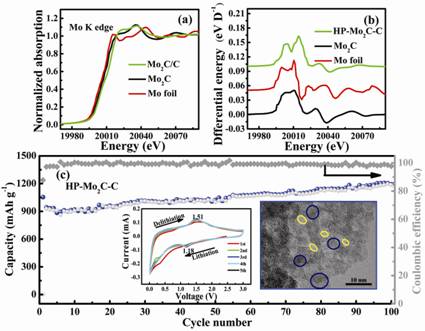Transition metal carbides have been widely used in catalysts area owing to their appealing chemical and physical properties including high melting point, high electrical conductivities, excellent mechanical stability and chemical stability, and the resistance against corrosion under reaction conditions. Recently, their applications in energy fields such as oxygen reduction reactions, hydrogen production and lithium ion batteries have received intensively investigated. With regards to their promising application in lithium ion batteries, most of the related research works refer to two-dimensional (2D) layered carbides. However, their limited capacities due to intrinsic structure features greatly hinder the practice applications. Therefore, it is highly desirable to develop other non-layered carbide electrode materials with high specific capacity for lithium ion batteries. A team from Beijing Institute of Technology reported on the successful synthesis of hierarchically porous Mo2C/C hybrid comprised with nanoparticels (4~7 nm) by a simple and effective freeze-drying method. Additionally, the structure characterization and Li-storage mechanism were also intensitively investigated. This research work has been published in the journal of Nano Energy on Dec., 2015.

(a) XANES spectra and (b) the corresponding derived differential spectra of the HP-Mo2C-C hybrid, Mo2C and Mo foil. (c) Cell performance of the HP-Mo2C-C hybrid at 100 mA g-1.
As the anode material, the as-synthesized carbide hybrid exhibits excellent cycling stability and high specific capacity. Among all the reported transition metal carbides-based electrode materials, the current material with this level of performance is the first time. In addition, the possible Li-storage mechanism and the reason for its superior performance were also proposed accoring to the related experimental results. In this work, Beijing Synchrotron Radiation Facility (BSRF) was used to investigate the interaction between Mo2C and C. The result indicates the presence of strong interaction between these two components, which is believed to be crucial for the achieving of excellent electrochemcal performance.
The current work not only proposes a facile and effcient strategy to synthesize non-layer nanoporous carbides, but also provides certain experiment fundation and theoretical basis for the research of carbides in batteries, exhibiting important research significance.
Article:
Ying Xiao, Lirong Zheng, Minhua Cao, Hybridization and Pore Engineering for Achieving High-Performance Lithium Storage of Carbide as Anode Material. Nano Energy 12 (2015) 152–160.


